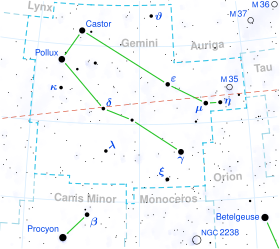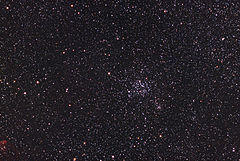| Observation data Epoch J2000 Equinox J2000 | |
|---|---|
| Constellation | Gemini |
| Right ascension | 06h 12m 19.09884s[1] |
| Declination | +22° 54′ 30.6531″[1] |
| Apparent magnitude (V) | 5.74 – 8.10[2] |
| Characteristics | |
| Spectral type | M1-2 Ia-Iab[3] |
| U−B color index | +1.93[4] |
| B−V color index | +1.63[4] |
| Variable type | LC[2] |
| Astrometry | |
| Radial velocity (Rv) | +27.16±0.42[5] km/s |
| Proper motion (μ) | RA: +0.144[1] mas/yr Dec.: −2.085[1] mas/yr |
| Parallax (π) | 0.5642 ± 0.0957 mas[1] |
| Distance | approx. 5,800 ly (approx. 1,800 pc) |
| Absolute magnitude (MV) | −6.32[6] |
| Details | |
| Mass | ~20[7] M☉ |
| Radius | 821+60 −27[8] R☉ |
| Luminosity | 86,000[9] L☉ |
| Surface gravity (log g) | 0.0[6] cgs |
| Temperature | 3,789[10] K |
| Other designations | |
| Database references | |
| SIMBAD | data |
6 Geminorum is a variable star in the zodiac constellation of Gemini, located roughly 5,800 light years away from the Sun. It has the variable star designation BU Geminorum; 6 Geminorum is the Flamsteed designation. At its brightest this reddish hued star is barely visible to the naked eye but is readily visible with binoculars, found southeast of M 35, just to the south of WY Geminorum. It is moving further from the Earth with a heliocentric radial velocity of +27 km/s.[5] The star is a member of the Gemini OB1 association.[12]
This is an evolved red supergiant with a stellar classification of M1-2 Ia-Iab.[3] It is a semiregular variable star, ranging from visual magnitude +5.7 down to +7.5 over a period of 325 days. It has been given the sub-classification of Lc, which means "Irregular variable supergiants of late spectral types having amplitudes of about 1 mag. in V.O".[13] The star has expanded to 821[8] times the Sun's radius and is radiating 86,000[9] times the luminosity of the Sun from its swollen photosphere at an effective temperature of 3,789 K.[10]
-
Messier 35, with 6 Gem visible right at the bottom edge of the image
References
[edit]- ^ a b c d e Vallenari, A.; et al. (Gaia collaboration) (2023). "Gaia Data Release 3. Summary of the content and survey properties". Astronomy and Astrophysics. 674: A1. arXiv:2208.00211. Bibcode:2023A&A...674A...1G. doi:10.1051/0004-6361/202243940. S2CID 244398875. Gaia DR3 record for this source at VizieR.
- ^ a b Samus, N. N.; Durlevich, O. V.; et al. (2009). "VizieR Online Data Catalog: General Catalogue of Variable Stars (Samus+ 2007-2013)". VizieR On-line Data Catalog: B/GCVS. Originally Published in: 2009yCat....102025S. 1. Bibcode:2009yCat....102025S.
- ^ a b Keenan, Philip C.; McNeil, Raymond C. (1989). "The Perkins catalog of revised MK types for the cooler stars". Astrophysical Journal Supplement Series. 71: 245. Bibcode:1989ApJS...71..245K. doi:10.1086/191373.
- ^ a b Mermilliod, J.-C. (1986). "Compilation of Eggen's UBV data, transformed to UBV (unpublished)". Catalogue of Eggen's UBV Data. Bibcode:1986EgUBV........0M.
- ^ a b Famaey, B.; et al. (January 2005). "Local kinematics of K and M giants from CORAVEL/Hipparcos/Tycho-2 data. Revisiting the concept of superclusters". Astronomy and Astrophysics. 430 (1): 165–186. arXiv:astro-ph/0409579. Bibcode:2005A&A...430..165F. doi:10.1051/0004-6361:20041272. S2CID 17804304.
- ^ a b Levesque, Emily M. (2005). "The Effective Temperature Scale of Galactic Red Supergiants: Cool, but Not As Cool As We Thought". The Astrophysical Journal. 628 (2): 973–985. arXiv:astro-ph/0504337. Bibcode:2005ApJ...628..973L. doi:10.1086/430901. S2CID 15109583.
- ^ "6 GEM". 2012. Retrieved 15 December 2016.
- ^ a b Norris, Ryan P. (2019). Seeing Stars Like Never Before: A Long-term Interferometric Imaging Survey of Red Supergiants (PDF) (PhD). Georgia State University.
- ^ a b Mauron, N; Josselin, E (2011). "The mass-loss rates of red supergiants and the de Jager prescription". Astronomy and Astrophysics. 526: A156. arXiv:1010.5369. Bibcode:2011A&A...526A.156M. doi:10.1051/0004-6361/201013993. S2CID 119276502.
- ^ a b Mármol-Queraltó, E; Cardiel, N; Cenarro, A. J; Vazdekis, A; Gorgas, J; Pedraz, S; Peletier, R. F; Sánchez-Blázquez, P (2008). "A new stellar library in the region of the CO index at 2.3 μm. New index definition and empirical fitting functions". Astronomy and Astrophysics. 489 (2): 885–909. arXiv:0806.0581. Bibcode:2008A&A...489..885M. doi:10.1051/0004-6361:200810044. S2CID 15411613.
- ^ "6 Gem". SIMBAD. Centre de données astronomiques de Strasbourg. Retrieved 2019-04-24.
- ^ Laur, Jaan; et al. (February 2017). "Variability survey of brightest stars in selected OB associations". Astronomy & Astrophysics. 598: 27. arXiv:1611.02452. Bibcode:2017A&A...598A.108L. doi:10.1051/0004-6361/201629395. S2CID 119076598. A108.
- ^ "Variable Star Type Designations in VSX]". Retrieved 2016-11-06.
- ^ "ASAS All Star Catalogue". The All Sky Automated Survey. Retrieved 8 December 2021.

![A light curve for BU Geminorum, plotted from TESS data[14]](https://upload.wikimedia.org/wikipedia/commons/thumb/0/0e/BUGemLightCurve.png/240px-BUGemLightCurve.png)

Well, that’s interesting to know that Psilotum nudum are known as whisk ferns. Psilotum nudum is the commoner species of the two. While the P. flaccidum is a rare species and is found in the tropical islands. Both the species are usually epiphytic in habit and grow upon tree ferns. These species may also be terrestrial and grow in humus or in the crevices of the rocks.
View the detailed Guide of Psilotum nudum: Detailed Study Of Psilotum Nudum (Whisk Fern), Classification, Anatomy, Reproduction